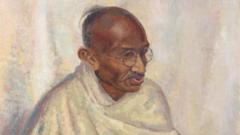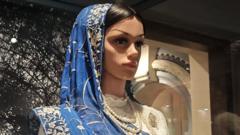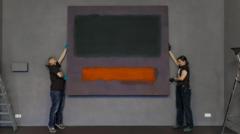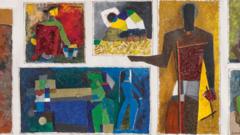As 25 MF Husain paintings prepare to compete at auction after years in vaults, this event reignites discussions about the artist’s legacy and his controversial past.
**India’s Masterpieces Unveiled: The MF Husain Auction Story**
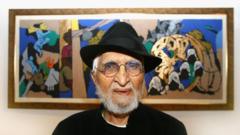
**India’s Masterpieces Unveiled: The MF Husain Auction Story**
Rare Husain paintings locked away for years are set for auction, revealing a vibrant chapter in Indian art history.
In a remarkable turn of events, nearly two dozen masterpieces by the iconic Indian artist MF Husain are slated to be auctioned for the first time next week, shedding light on their existence that has been hidden from public view. Scheduled for June 12, 25 rare paintings are due to be presented at the Pundole Art Gallery in Mumbai, marking the first public display since they were seized in 2008 due to a loan default by a prominent businessman.
Dadiba Pundole, the director of the gallery, reflected on the significance of this moment, saying, “It's like the paintings have come full circle.” The artworks are part of a larger collection that was once involved in a billion-rupee agreement signed by Husain in 2004 with businessman Guru Swarup Srivastava. Despite Husain's stature as “the Picasso of India,” the deal culminated in controversy when authorities began investigating Srivastava's business dealings.
Husain, who died in 2011, created these influential pieces during the early 2000s, expressing his reflections on a tumultuous century marked by significant technological, political, and cultural changes. Pundole anticipates that the auction could generate up to $29 million, especially after another Husain piece, Untitled (Gram Yatra), recently achieved a record-breaking $13.8 million at a Christie's auction.
Locked away for almost 15 years due to the ongoing legal proceedings surrounding Srivastava, a court ruling earlier this year has allowed these paintings to finally be auctioned off, ostensibly to recover part of the loan linked to their predicament. The narrative surrounding these pieces has been characterized by competitive dynamics within the Indian art scene, as detailed by art historian Kishore Singh.
Though Srivastava maintains that claims against him are unfounded, the ongoing court cases have kept the spotlight on Husain’s artworks. In a previous interview, Srivastava expressed regret over the failed deal to finalize payments for the paintings, which complicates the artist's legacy.
The upcoming auction is poised to showcase Husain’s acrylics on canvas, reflecting key 20th-century events and human experiences. This vibrant collection includes themes of coexistence, sociopolitical reflections, and commentary on war and peace, capturing the essence of the artist’s celebrated style. As these once-concealed pieces return to public engagement, they not only rejuvenate interest in Husain's work but also conjure questions about the intersection of art, commerce, and cultural heritage in India.
Dadiba Pundole, the director of the gallery, reflected on the significance of this moment, saying, “It's like the paintings have come full circle.” The artworks are part of a larger collection that was once involved in a billion-rupee agreement signed by Husain in 2004 with businessman Guru Swarup Srivastava. Despite Husain's stature as “the Picasso of India,” the deal culminated in controversy when authorities began investigating Srivastava's business dealings.
Husain, who died in 2011, created these influential pieces during the early 2000s, expressing his reflections on a tumultuous century marked by significant technological, political, and cultural changes. Pundole anticipates that the auction could generate up to $29 million, especially after another Husain piece, Untitled (Gram Yatra), recently achieved a record-breaking $13.8 million at a Christie's auction.
Locked away for almost 15 years due to the ongoing legal proceedings surrounding Srivastava, a court ruling earlier this year has allowed these paintings to finally be auctioned off, ostensibly to recover part of the loan linked to their predicament. The narrative surrounding these pieces has been characterized by competitive dynamics within the Indian art scene, as detailed by art historian Kishore Singh.
Though Srivastava maintains that claims against him are unfounded, the ongoing court cases have kept the spotlight on Husain’s artworks. In a previous interview, Srivastava expressed regret over the failed deal to finalize payments for the paintings, which complicates the artist's legacy.
The upcoming auction is poised to showcase Husain’s acrylics on canvas, reflecting key 20th-century events and human experiences. This vibrant collection includes themes of coexistence, sociopolitical reflections, and commentary on war and peace, capturing the essence of the artist’s celebrated style. As these once-concealed pieces return to public engagement, they not only rejuvenate interest in Husain's work but also conjure questions about the intersection of art, commerce, and cultural heritage in India.





